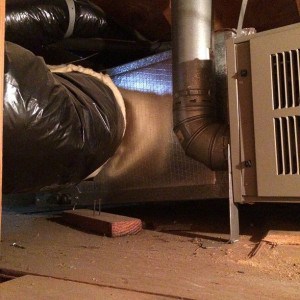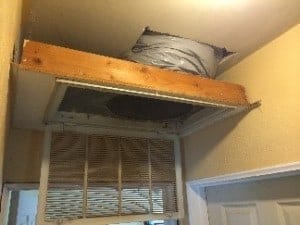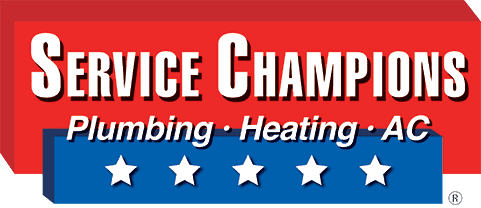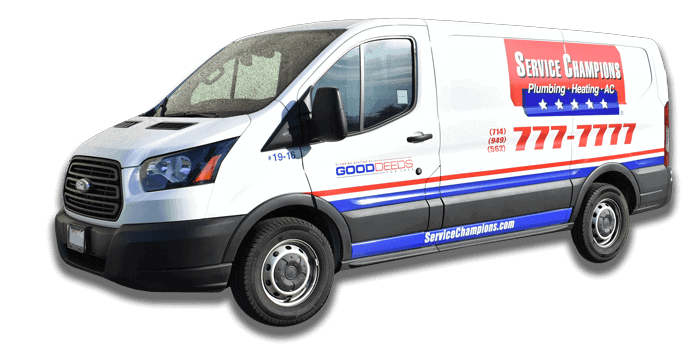Common Mistakes Found in AC Installations
Is Your AC System Installed Correctly?
Air conditioning installations are a lengthy and complicated process. Even after the initial installation, central air system need regular AC tune-ups and maintenance checks to last long and perform well. Sometimes, you may experience trouble with your air conditioner and unfortunately, they may stem from faulty installation work. Whether a small process has been overlooked or equipment has been simplified, there are some common mistakes we find left over by other HVAC technicians when we come by for maintenance calls. Specifically, many mistakes are related to water drainage and prevention tools.
The Ceiling Saver Kit is Missing
Generally speaking, there are two types of installations that can be done. First, the horizontal application calls for the air conditioner to be installed in the attic or under the home with the unit down on its side. This type of application is found more so in modern or newer homes.
Proper Installation of Horizontal System
As long as the horizontal application has been completed perfectly there should be no dangers, inconveniences or troubles during the lifespan of furnace use. However, because with the horizontal application the air conditioner is kept in the attic, improper drainage can cause the roof to leak, inviting water damage and microbiological growth, which later requires roof or ceiling restoration.

Improper Drainage
For this reason, a horizontal application should come with a secondary drip pan in the event that the first drip pan or drainage pipes are filled or clogged. Drip pans are responsible for collecting water that forms through condensation, another process necessary for successful air conditioning. When this small supply of water has no exit route, it collects inside of the home and the air conditioner itself. Be sure to ask your HVAC technician to supply and test a secondary drip pan, which we call a “ceiling saver kit”, to prevent any potential for water damage.
Drain Pipes Lead to No Exit
The second type of installation is called an upflow application with the air conditioner standing upright in a closet. All central air systems require some type of drain pipe that removes water collecting inside to an external location.
Because the upflow application is more common to older homes, oftentimes home renovation is completed without much thought to the existing central air system. In several cases, the original AC installation had a drain pipe leading to location outside of the home and worked successfully. Years later, renovation takes place and new features trump the drain pipes.
For example, a sidewalk is built over the drain pipe. Now, though the AC continues to run with water traveling through the drain pipe, it has no place to empty. What results is build up and back up that traces its way back to the furnace closet inside the home. Old water and even yard waste that made its way into the pipes from outside can clog the drain pipes and damage not only the system, but the home as well.
To fix this, your HVAC technician can work to reroute the drainage pipes to an available location. If that is not possible, he can use what is called a condensation pump. It is a pump that works to propel water into a different location, whether that’s an alternative drain pipe or exit route.
A Basic Faulty Installation
Some installations, no matter the application, are faulty in nature. Though simplified versions of installation may prompt homeowners to think it saves on costs, its design affects far more than economy.
This type of work implies several different problems.
When our technicians visited a client’s home for an AC maintenance call, this is what we found:

Bad Register Installation
What We’re Looking At Above:
- Horizontal Application – the duct leads to the air conditioner kept in the attic.
- Return Grill – the register (that hangs open) is a vent that allows indoor air supply to enter the air conditioner for cooling and heating.
- Rough Cut-Out of Drywall Ceiling – in the shape of a square with the circular air duct sticking out of it.
A false ceiling was built in order to accommodate a lower return grill. In doing so, the air duct was pulled out of the attic and lowered to match the return grill.
The Problems and Its Consequences:
- No filter – it should be between the register and the duct itself. That means that air is not filtered of pathogens or particles before being conditioned.
- Return Grill was built lower instead of being re-framed at normal ceiling height – this compromises aesthetics.
- Return Air Duct is not fitted – this allows for limited indoor air supply and contradicting temperatures.
A closer look at the first photo reveals that the air duct fitted into the square-cut hole has allowed four empty corners through which a secondary air supply can enter. This later becomes a costly problem.
The air duct pulls air from inside the home to be conditioned. Home air is at what is called ambient temperature. The open corners of the ceilings allow for a secondary source of air from the attic, which, due to little ventilation, is much hotter and dirtier than home air. This causes longer periods of air conditioning because two different temperature air supplies need conditioning to one temperature set on the thermostat.
Service Champions’ Method of AC Installation
Precise and efficient air conditioning depends on the accuracy of the AC installation. For this reason, we at Service Champions ensure a perfect installation with each and every furnace and air conditioner.
As technicians, we train for 150 hours each year in our own private training facility. Our training provides new information and technology within the HVAC industry. When we come to service your central air system, it is being handled with the most advanced methods available.
All members pass drug tests and background checks. For your additional security, we send an e-mail containing the photo IDs of your technicians visiting prior to the appointment.
If you would like to have your air conditioner maintained or repaired, contact our friendly representatives in the call center to schedule a visit best fit for you.

